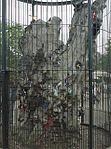Ivy Cottage
Houses in the Royal Borough of Kensington and ChelseaKensington PalaceRoyal residences in the United KingdomUse British English from September 2019

Ivy Cottage is a house in the grounds of Kensington Palace in London, England. It is a grace-and-favour property, originally housing servants. Princess Eugenie, and her husband, Jack Brooksbank, resided in the cottage from April 2018 to November 2020. It is close to Nottingham Cottage, the former home of the Duke and Duchess of Sussex.
Excerpt from the Wikipedia article Ivy Cottage (License: CC BY-SA 3.0, Authors, Images).Ivy Cottage
Kensington Palace Gardens, London South Kensington (Royal Borough of Kensington and Chelsea)
Geographical coordinates (GPS) Address Nearby Places Show on map
Geographical coordinates (GPS)
| Latitude | Longitude |
|---|---|
| N 51.5061 ° | E -0.18905 ° |
Address
Kensington Palace Gardens 15b
W8 4QN London, South Kensington (Royal Borough of Kensington and Chelsea)
England, United Kingdom
Open on Google Maps








